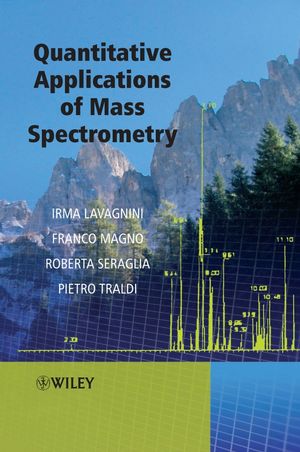Quantitative Applications of Mass SpectrometryISBN: 978-0-470-02516-1
Paperback
152 pages
May 2006
 |
||||||
Acknowledgements.
Introduction.
1 What Instrumental Approaches are Available.
1.1 Ion Sources.
1.1.1 Electron Ionization.
1.1.2 Chemical Ionization.
1.1.3 Atmospheric Pressure Chemical Ionization.
1.1.4 Electrospray Ionization.
1.1.5 Atmospheric Pressure Photoionization.
1.1.6 Matrix-assisted Laser Desorption/Ionization.
1.2 Mass Analysers.
1.2.1 Mass Resolution.
1.2.2 Sector Analysers.
1.2.3 Quadrupole Analysers.
1.2.4 Time-of-flight.
1.3 GC/MS.
1.3.1 Total Ion Current (TIC) Chromatogram.
1.3.2 Reconstructed Ion Chromatogram (RIC).
1.3.3 Multiple Ion Detection (MID).
1.4 LC/MS.
1.5 MS/MS.
1.5.1 MS/MS by Double Focusing Instruments.
1.5.2 MS/MS by Triple Quadrupoles.
1.5.3 MS/MS by Ion Traps.
1.5.4 MS/MS by Q-TOF.
References.
2 How to Design a Quantitative Analysis.
2.1 General Strategy.
2.1.1 Project.
2.1.2 Sampling.
2.1.3 Sample Treatment.
2.1.4 Instrumental Analysis.
2.1.5 Method Validation.
References.
3 How to Improve Specificity.
3.1 Choice of a Suitable Chromatographic Procedure.
3.1.1 GC/MS Measurements in Low and High Resolution Conditions.
3.1.2 LC/ESI/MS and LC/APCI/MS Measurements.
3.2 Choice of a Suitable Ionization Method.
3.3 An Example of High Specificity and Selectivity Methods: The Dioxin Analysis.
3.3.1 Use of High Resolution MID Analysis.
3.3.2 NICI in the Analysis of Dioxins, Furans and PCBs.
3.3.3 MS/MS in the Detection of Dioxins, Furans and PCBs.
3.4 An Example of MALDI/MS in Quantitative Analysis of Polypeptides: Substance P.
References.
4 Some Thoughts on Calibration and Data Analysis.
4.1 Calibration Designs.
4.2 Homoscedastic and Heteroscedastic Data.
4.2.1 Variance Model.
4.3 Calibration Models.
4.3.1 Unweighted Regression.
4.3.2 Weighted Regression.
4.3.3 A Practical Example.
4.4 Different Approaches to Estimate Detection and Quantification Limits.
References.
Index.



